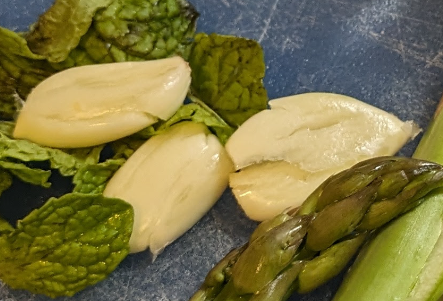On an average day, I get up at 6:45am, take the dogs out, hop in the shower, get dressed, grab my lunch, and head to work. I get to work around 8-8:30 (depending on when I leave, traffic, and if I have to make any stops). I leave work around 5pm and arrive at the house close to 6. I check the mail, go inside, pet the dogs, let Nadia up onto the bed to lie down, use the bathroom, change clothes, let Nadia back out of the bedroom, and head to the kitchen to start dinner right around 6:15. I generally turn the burner on around 6:50. For that 35 minute span, it's just me, my music, my cutting board, my knife, my bowls, an assortment of herbs and vegetables, and a piece or two of protein (usually meat, occasionally tofu). Those 35 minutes are when I compose my recipe, plan my cuts and seasoning, and start executing. I sharpen my knife and get to work. How you prep your ingredients affects every other step of the dinner process: cook order, cook times, presentation. It affects the flavor and aroma. It is, in my uneducated, low experience opinion, the most exciting step in cooking.
I know there are plenty of ways to speed up the process, but it's become a sort of ritual for me, especially when it comes to peeling garlic. I go a clove at a time, giving it a little twist to crack the skin and loosen it from the clove, then peel it off a piece at a time. Each clove takes close to a minute, and while, like I said, this process could be greatly accelerated, it's almost meditative to spend that much time focused on such minute details, and, as my hands do their work, it gives my mind a chance to focus up and start composing my meal. I plan each dish, decide what happens when, and design every detail up to presentation.
- If I want to use it as a base flavor in a dish, I'll mince it. I generally will drop minced garlic into a pan of oil or butter before I add my key ingredient. When it's minced, the garlic's oil is able to quickly infuse whatever you're cooking with it so that the flavor can spread throughout the entire dish. I mince like Jacques Pepin taught me: crush the clove flat, slice it thinly one way, then slice it thinly the other way.
- When I want garlic in my sauce, I'll crush the clove and slice it longways. This still allows a bit of infusion, but also gives you a little bit of the actual clove to bite into and notice. Because it's such a small piece, the flavor isn't too strong but is still present, and the texture is always a nice addition.
- On the frequent occasions that I want to really notice the garlic in a dish, I'll slice it longways without crushing. I call this "slivering," and I have no idea if that's a proper term. I love dropping in a flew slivered cloves when I'm sautéing veggies, particularly kale or spinach. I generally start by heating up a good amount of oil, dropping in the garlic and a palmful of red pepper flakes to really get the flavors blended with whatever I end up cooking in there. If I want the garlic to have a bit of a crisp to it, I'll leave it in for a little while before adding the other ingredient(s).
- If I'm doing a heartier vegetable blend, I'll slice the garlic crosswise, getting some nice disc-shaped slices. I determine the thickness of the slices based on whether I'm more interested in the texture and the flavor concentration: the thinner I slice, the less and more I get, respectively. I generally go thicker, maybe 1/16 of an inch, so I know when I bite into a slice. While this imparts a bit less flavor to the dish overall, it's usually how I want it to go.
- If I'm making a stew, a sauce I'm going to throw in the food processor to smooth out, or am more interested in having the flavor without any of the texture in the final dish, I'll just crush it with the flat of my knife. This can also be useful for plating because having a browned full-sized clove of garlic on the plate just looks badass.








Comments
Post a Comment